Today's top static testing meters offer diverse measurement capabilities to match your specific needs. The HAUG Static Meter I and Digital Static Field Meter excel with ranges up to ±19.99 kV at 1-inch distance, while the HAUG Digital Static Control Meter reaches 2000 kV/m. For precision work, you'll find the STS 1 measuring down to 1 volt, and the FMX-004 covering both low and high ranges up to ±30.00 kV. Features like LED rangefinders, digital displays, and peak hold functions vary across models, affecting both accuracy and ease of use. Additional capabilities like air ion balance testing and ultrafast response times can make the difference in your selection process.
Essential Features for Static Testing
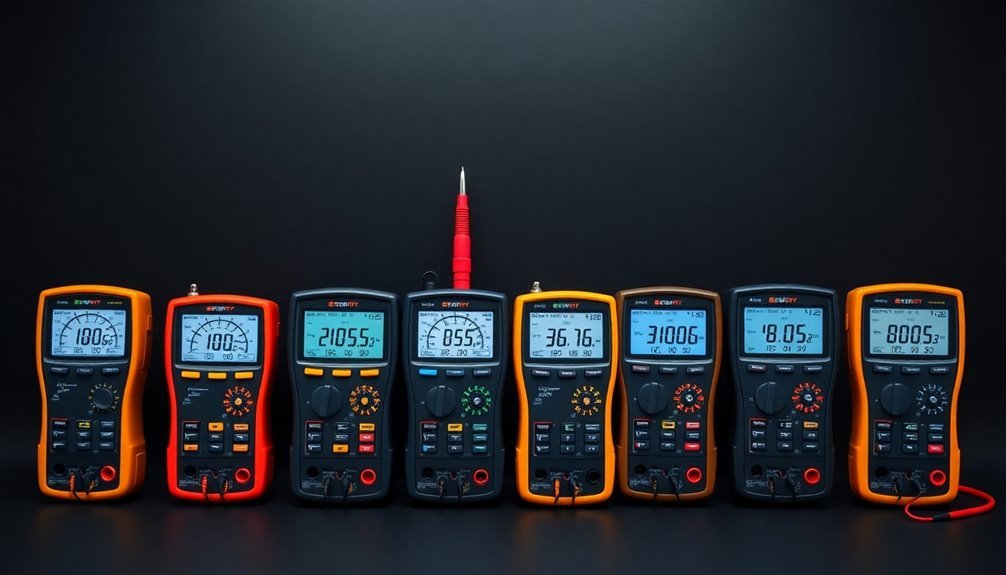
Reliability in static testing depends on meters equipped with vital measurement capabilities. When you're selecting a static testing meter, you'll want to focus on devices that offer high sensitivity readings of one volt at 2.5 cm and fall within accuracy classes 0.2S or 0.5S. The ability to scan through voltage ranges of ±29,999 ensures comprehensive testing across varying charge levels.
Look for meters featuring chopper-stabilized sensors, which guarantee accurate measurements in both normal and ionized environments.
You'll need a meter that provides ultrafast response times of 0.005 seconds to detect static sources quickly. Digital displays are essential for precise readings, and you should prioritize meters that measure both DC electric field strength and approximate AC voltage.
The ability to measure air ion balance and surface conductivity adds versatility to your testing capabilities.
For practical field use, choose meters that offer non-contact measurement features and LED ranging lights to guide you to the correct measurement distance.
Data logging capabilities are vital if you'll need to track measurements over time. Consider meters with built-in peak hold functions to capture the most negative and positive voltages, and make certain your chosen model includes user-settable alarms for high readings.
Measurement Range Capabilities
When selecting a static testing meter, you'll find that most models offer multiple measurement ranges from as low as 0-10 kV at 1 cm to as high as 200 kV at 20 cm distances.
Your meter's field strength detection capabilities directly correlate to the measurement distance, with closer ranges providing more precise readings for lower voltages. A key advantage is that measurements are taken without withdrawing field energy during testing.
The standard variable distance options (1 cm, 2 cm, 5 cm, 10 cm, and 20 cm) let you adapt your testing approach based on your specific voltage measurement needs.
Low to High Voltages
Modern static testing meters offer impressive measurement capabilities across three distinct voltage ranges.
You'll find that low-voltage measurements (up to 1 kV) are handled with exceptional precision, with devices like the Static Volt Meter and Electrostat ES3 offering resolution down to 1-volt steps, while the FMX-004 covers ranges up to ±1.49 kV in its low setting. Constant voltage sourcing is essential for maintaining measurement accuracy in this range.
For mid-range voltages (1 kV to 10 kV), you can rely on continuous measurement capabilities without switching ranges. The Static Volt Meter and Electrostat ES3 maintain their precision up to ±29,999 volts, while the FMX-004 seamlessly shifts to its high range mode for measurements up to 30 kV.
In the high-voltage range (10 kV to 30 kV), these meters continue to deliver accurate readings. You'll appreciate features like the Static Volt Meter's consistent 1-volt resolution and the FMX-004's LED guide for correct measuring distance.
For ideal accuracy across all ranges, you can employ lock-in techniques and high-impedance divider methods to minimize circuit impact. The meters' additional features, such as peak hold functions and ultrafast response times, guarantee you're getting reliable measurements regardless of the voltage range.
Field Strength Detection Limits
The diversity of field strength detection capabilities across static testing meters enables precise measurements for various applications.
You'll find the SMP3 offers the highest frequency range, measuring up to 60 GHz for broadband applications, while providing spectrum analysis capabilities up to 10 MHz.
For static field measurements, the Digital Static Field Meter delivers readings of ±19.99 kV at a fixed 1-inch distance, featuring ranging lights for accurate positioning.
The Static Meter I expands this capability with measurements up to 200 kV, allowing variable measuring distances and utilizing the fieldmill influence principle for enhanced sensitivity. The auto-gain function ensures optimal peak detection during dynamic processes like welding operations.
In medical environments, Magnetic Resonance Clinical Systems maintain strict limits, keeping RF magnetic field strength below 0.05 A/m outside the magnet housing, with a 2.5 T limit for whole body exposure.
You'll need to match your meter's capabilities to your specific application – whether it's compliance with international standards like the EU Directive 2013/35 using the SMP3, or manufacturing process monitoring with the Static Meter I.
Remember that some meters, like the Static Meter I, aren't approved for hazardous locations despite their advanced measurement capabilities.
Distance-Based Measurement Specs
Accurate field strength measurements depend heavily on the distance between the meter and the measured surface.
When measuring at 1cm distance, the Nex Flow offers a 0-10 kV range with 1V resolution, while the Desco 19442 provides 0 to ±19.99 kV measurements with ±5% accuracy. The AP-YV1303 maintains a consistent 0.1-±200.0 kV range across various distances. For optimal accuracy, most meters utilize LED rangefinder systems to ensure correct positioning.
At 2cm, you'll get expanded capabilities with the Nex Flow, measuring up to 20 kV with 2V resolution. The measurement range increases further at 5cm, where the Nex Flow can detect up to 50 kV with 10V resolution.
While the Desco 19442 doesn't specify direct measurements for 2cm and 5cm distances, it offers scalable measurements – you'll multiply the reading by the distance in inches.
The HAUG meters take a different approach, with their standard model measuring field strength from 0-2000 kV/m without distance-specific ranges. The Statometer II/III models don't specify distance-based measurements.
When choosing your meter, you'll need to take into account these distance-based specifications carefully, as they'll directly impact your measurement accuracy and reliability.
Display Types and Data Output
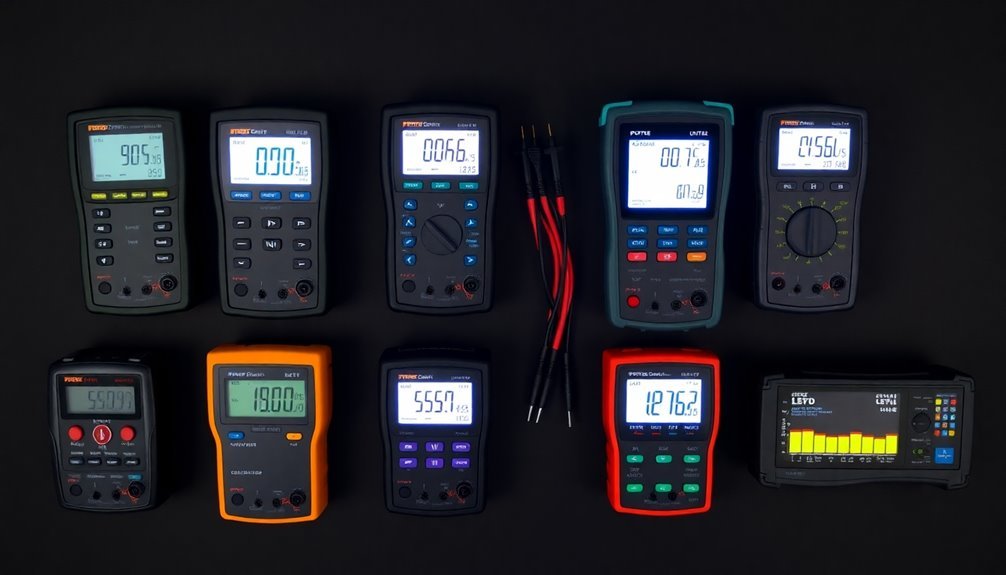
Static testing meters employ various display and output options to deliver precise measurement data to users. They feature digital displays with LCD screens that show both positive and negative voltage values, often with two-line, 12-digit readouts for thorough measurements.
These displays typically include peak hold values and alarm status indicators to help you monitor static charges effectively. Modern meters now offer 3.2-inch IPS touchscreens with adjustable brightness settings and light/dark modes for enhanced visibility.
When you need more detailed analysis, analog outputs let you connect your meter to external devices like oscilloscopes or multimeters. These outputs represent 1/10000 of the actual voltage at specified distances, providing true waveform data including both DC and AC components.
You'll get measurement ranges from 0 to 29,999 volts, with sensitivity down to 1 volt and multiple distance options for effective testing.
Your data management capabilities include peak hold functions that capture the highest positive and negative signals, while user-configurable alarms alert you when voltages exceed set thresholds. You can reset readings manually to start fresh measurements, and many devices offer visual indicators to help you track alarm status and peak hold information.
These features guarantee you'll get accurate, detailed static charge measurements for your specific testing requirements.
Ease of Operation Analysis
Modern static testing meters let you choose between one-touch operations for quick measurements or multi-button controls for more detailed testing functions.
Digital static meters provide numerical readings that are significantly easier to interpret than analog displays, making operation more intuitive for users of all skill levels.
You'll find that display readability varies substantially among models, with some offering backlit LCD screens and others featuring simple LED indicators for different measurement ranges.
Quick setup features like automatic ranging and LED positioning guides help you start taking accurate measurements right away, regardless of your experience level.
One-Touch Vs Multi-Button Controls
In today's testing environment, choosing between one-touch and multi-button controls substantially impacts a meter's ease of operation.
One-touch controls offer simplicity through minimal user interaction, making them ideal for basic operations. They're cost-effective and particularly suitable for straightforward testing scenarios, though they come with noticeable responsiveness limitations and can't support complex gestures. Similar to single-touch attribution models, this straightforward approach works best for uncomplicated processes.
Multi-button controls, while more expensive, provide enhanced functionality and responsiveness. They support simultaneous interactions and complex gestures, making them more versatile for advanced testing applications.
When selecting between these options, consider these key factors:
- Task Complexity – One-touch controls work best for simple, sequential operations, while multi-button interfaces excel at complex, simultaneous actions
- User Expertise – Less technically proficient users may prefer one-touch simplicity, while experienced technicians might benefit from multi-button functionality
- Testing Environment – Consider space constraints and whether you'll need advanced gestures or simple taps
- Cost Considerations – Balance the higher cost of multi-button systems against your need for advanced features and faster response times
The choice ultimately depends on your specific testing requirements, user proficiency, and budget constraints.
Display Types and Readability
When choosing a static testing meter, display readability can make or break your testing efficiency. Most modern meters feature LCD or digital displays that provide clear numerical readings, while some include LED indicators for quick status checks.
You'll find that backlit displays greatly improve visibility in low-light conditions, making them essential for varied work environments.
Display resolution and accuracy are vital factors to take into account. Look for meters offering high-resolution measurements, typically in 1-volt steps, and accuracy ratings of ±5% or better.
Many top models include helpful features like display hold and peak hold functions, allowing you to freeze readings or capture maximum values during testing. You'll also want to check for polarity indication and user-settable alarms that alert you when voltages exceed specified thresholds.
For precise measurements, take into account meters with built-in rangefinder systems, which help you maintain the correct measurement distance. Some advanced models offer specialized features like air ion measurement, conductivity approximation, and voltage differential measurement capabilities.
Don't overlook the importance of clear button labeling and intuitive interfaces, as these elements substantially impact your daily testing efficiency.
Quick Setup Features
Today's static testing meters prioritize straightforward setup procedures across various models. You'll find that most devices require minimal installation, with many offering plug-and-play functionality for immediate use in both laboratory and field environments.
When comparing setup features across different meters, you'll notice several key advantages:
- Portable meters like the HAUG Static Meter and Digital Static Control Meter offer single-button operation, allowing you to start measuring immediately without complex configurations.
- The Electrostat ES3's magnetic spacer guarantees consistent positioning at 1" from test surfaces, eliminating the need for manual distance calculations.
- The Statometer II & III series provides flexibility with both analog and digital displays, letting you choose your preferred reading method without additional setup steps.
- The HSM 1 High Voltage Meter includes a specialized high-voltage socket for direct connection to ionizing units, streamlining the setup process for voltage measurements.
For maintenance and calibration, most meters come pre-calibrated for specific measurement ranges. While the HAUG Static Meter and Electrostat ES3 have clearly defined calibration specifications, you'll want to verify calibration requirements for other models before purchase, as some manufacturers don't specify these details.
For instance, the HAUG Static Meter is pre-calibrated and ready for use, combining easy operation with accurate measuring techniques. Similarly, the Newhai Electrostatic Field Meter is designed for accurate measurements with a defined test range and accuracy specifications, ensuring it is ready for immediate use.
Field Strength Testing Performance
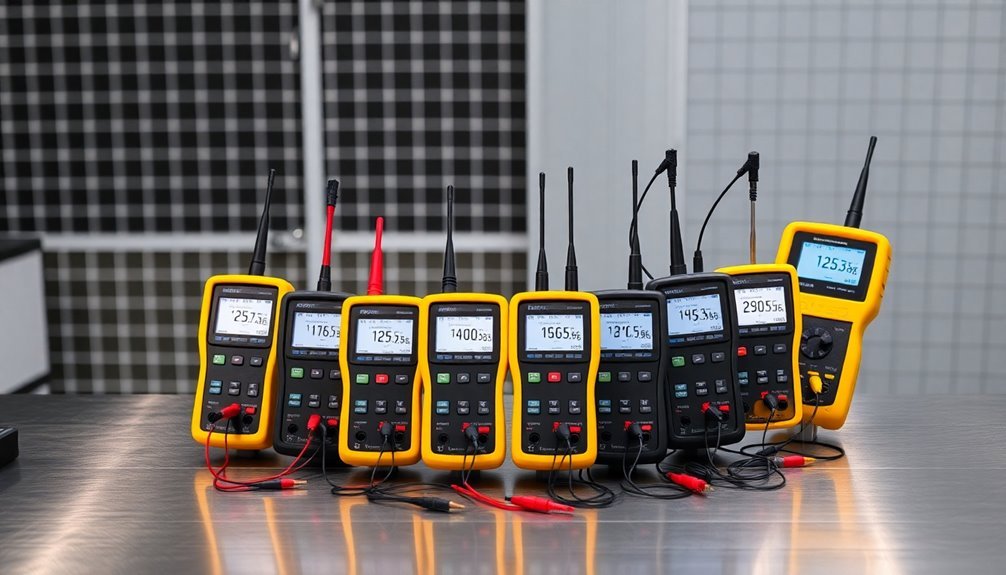
Through advanced digital displays and precise measurement capabilities, modern static testing meters excel at field strength testing performance.
You'll find that leading manufacturers like HAUG and Nex Flow offer meters with digital displays that provide accurate voltage readings and field strength measurements.
When testing field strength, you can rely on meters like HAUG's Digital Static Control meter, which measures up to 2000 kV/m.
The Static 1 Digital Static Meter lets you select incremental distances between the test object and sensor head, ensuring maximum measurement accuracy. Most meters utilize the field influence principle C for precise charge detection.
You'll appreciate features like the Hold function on the Hand-Held Static 1, which allows you to retain measured values on the display.
HAUG's Statometer III gives you the flexibility of both analog and digital displays while measuring electrostatic and slow alternating fields.
For specialized applications, the HAUG High Voltage Meter (HSM 1) measures AC voltages up to 10 kVAC with an additional high-voltage socket.
These meters combine precision with wide-range application capabilities, making them suitable for both laboratory testing and on-machine measurements.
Surface Voltage Detection Methods
You'll find that surface voltage detection relies heavily on field influence measurement, where changes in electric fields create measurable signals as your probe moves near the tested surface.
Modern contact-free detection technologies build upon the classic Kelvin probe technique, letting you measure surface potentials without physically touching the material.
These non-contact methods offer you precise measurements while protecting both the testing equipment and the surface being evaluated from potential damage through accidental contact.
Field Influence Measurement Principles
Static charge detection systems rely on two primary field influence measurement principles: the fieldmill influence method and the vibrating capacitor method. These non-contact techniques let you measure electrostatic charges and surface voltages without withdrawing energy from the tested material.
The fieldmill influence method uses sensor plates that are cyclically covered and uncovered to convert electric field strength into measurable alternating current. You'll find this technique in devices like the Haug Static Meter I, which offers adjustable measuring distances for ideal results.
The vibrating capacitor method, based on Lord Kelvin's principles, uses probes that vibrate to change capacitance and detect surface potential. You'll need to pay attention to probe-to-surface distance, as it affects measurement resolution.
When you're working with these systems, remember these key operational factors:
- Measuring sensitivity increases as you decrease the distance between probe and surface
- Scanning mode requires careful probe movement to detect potential changes accurately
- Avoid probe contact with surfaces to prevent damage to both probe and test material
- Select incremental measuring distances based on your specific application requirements
Contact-Free Detection Technologies
Modern contact-free detection technologies offer precise surface voltage measurements without ever touching the material being tested. These systems rely on the principle of electrostatic induction and typically use a vibrating capacitor method that Lord Kelvin first proposed in 1898, though it's been refined substantially since then.
You'll find two main probe types in today's testing meters: vibrating Kelvin probes that move perpendicular to the surface and lateral probes that scan parallel to it. Each probe type's effectiveness depends on factors like distance from the surface and vibration frequency, with probe size directly affecting measurement resolution.
When you're testing sensitive materials, you'll appreciate that contact-free detection prevents surface damage and contamination while maintaining high measurement precision. This technology's particularly valuable in semiconductor manufacturing, where static damage can be catastrophic, and in quality control processes where surface integrity is vital.
You can use these meters to detect static charges on electronic components, evaluate surface treatments and coatings, and identify insulation leaks. The non-destructive nature of these tests means you're able to perform repeated measurements without compromising the material's properties or surface characteristics.
Laboratory Testing Applications
Precision instruments designed for laboratory testing provide essential static measurement capabilities across numerous applications. You'll find that modern static testing meters offer exceptional accuracy and versatility, with devices like the Electrostat ES3 delivering resolution down to 0.001kV for precise measurements in controlled environments.
When selecting laboratory testing equipment, you'll want to take into account these critical features:
- Resolution sensitivity – The Electrostat ES3's 1-volt precision makes it ideal for detailed research and development work.
- Measurement range flexibility – Haug's Statometer series handles both electrostatic and alternating fields, adapting to various testing scenarios.
- Calibration accuracy – The Model 4406's Faraday Cage technology guarantees reliable, repeatable results.
- Environmental compatibility – Many meters work effectively in cleanrooms and specialized laboratory settings.
You can enhance your testing capabilities with instruments like the Static Meter I for hand-held applications or the HSM 1 for high-voltage AC measurements up to 10kVAC.
The Model 4406 Static Decay Meter's versatility allows you to test multiple materials, including films, fabrics, and plastics, making it particularly valuable for thorough laboratory research.
Industrial Environment Measurement Standards
The measurement of industrial environments must comply with strict regulatory standards, including Rule 1070 of OSHS and ISO 45001 guidelines. When you're selecting and using static testing meters, you'll need to guarantee they meet these established threshold limit values for toxic substances and physical agents in your workplace.
Work Environment Measurement (WEM) requirements encompass several key aspects: air quality monitoring, temperature control, humidity levels, pressure readings, and illumination standards. Your static testing equipment must be capable of accurately measuring these parameters while adhering to general ventilation specifications.
To maintain compliance, you'll need to follow a systematic approach that includes regular plant walk-throughs, careful selection of measurement areas, and proper equipment calibration.
Your testing process should incorporate the four elements of industrial hygiene: anticipation of potential risks, recognition of existing hazards, evaluation through sampling and analysis, and implementation of necessary controls.
You're required to maintain detailed records of all measurements and make them available to enforcing authorities. Your static testing program should also facilitate worker participation and support continuous improvement efforts as mandated by ISO standards.
Calibration and Maintenance Requirements
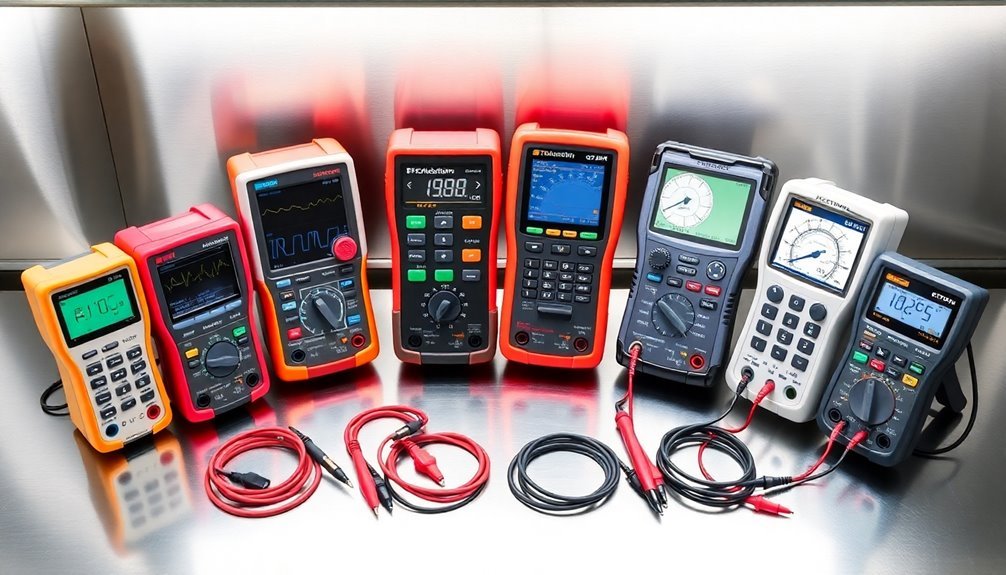
Regularly calibrating and maintaining your static testing meters is essential for achieving reliable measurements in industrial environments. You'll need to follow specific procedures to guarantee accuracy and compliance with industry standards.
The calibration process requires temperature stabilization and three preloading cycles, each lasting 30 seconds, before you can begin the actual calibration steps.
For proper calibration and maintenance, follow these critical requirements:
- Perform calibration at discrete, equally spaced torque values, using at least 5 steps from 20% to 100% of maximum torque value.
- Test the meter in different mounting positions (0°, 120°, 240°) to guarantee thorough validation.
- Document all calibration results, including sensitivity factors and mean values for each torque step.
- Schedule regular recalibration when you notice inaccuracies or after physical stress to the device.
You'll need to maintain detailed records of your calibration processes and guarantee they're traceable to national standards like NIST. Keep in mind that unauthorized servicing can void your warranty, so it's important to follow the manufacturer's guidelines for maintenance and recalibration schedules.
Remember to zero the indication at the start of each measurement series for precise accuracy.
Cost Benefit Comparison
Making a smart investment in static testing meters requires careful evaluation of both costs and benefits. You'll find that device complexity, range sensitivity, and brand reputation substantially influence initial costs. More advanced features and wider testing ranges typically command higher prices, while additional accessories can further impact your budget.
When analyzing the return on investment, you'll need to convert your testing hours into dollar amounts and compare them with traditional testing costs.
Early defect detection through static testing can save you 10-20 times the cost of fixing issues later in development. You're also likely to see reduced fixing times and decreased resource requirements, which directly impact your bottom line.
The cost-effectiveness of static testing becomes apparent when you consider its efficiency in detecting defects early in the SDLC. You'll spend less on maintenance and testing resources while improving overall code quality.
While high-end electro-mechanical systems like Matest's STS-25 may seem expensive initially, they often justify their cost through enhanced testing capabilities and reliable results.
To maximize your investment, you'll want to balance the meter's features against your specific testing needs and budget constraints.
Industry Certification Compliance
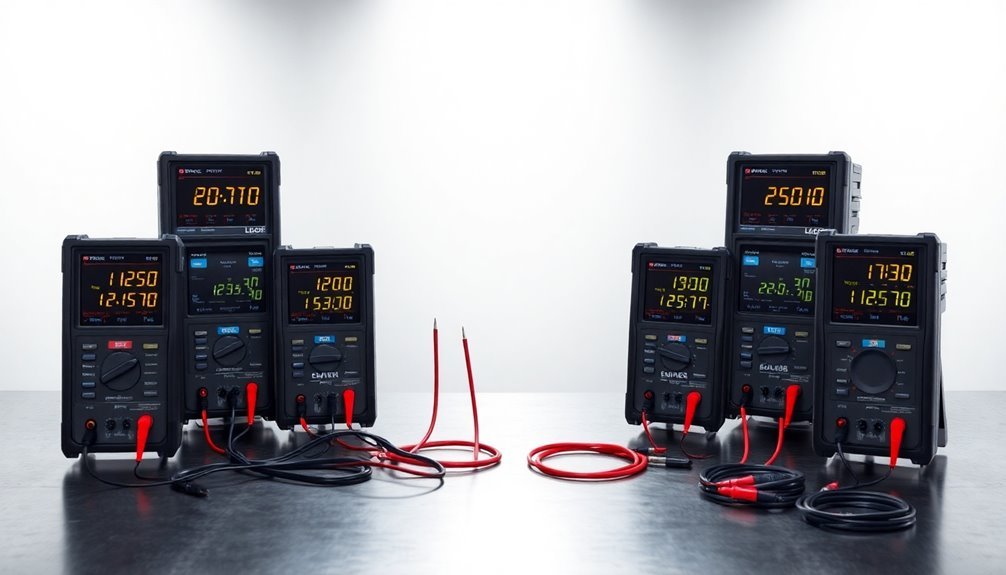
Beyond cost considerations, industry certification compliance shapes how you'll implement and maintain static testing meters. Your testing tools must align with ISTQB certification standards, which have become increasingly stringent with recent updates like CTFL 4.0.
You'll need to certify that your static testing meters meet both foundational requirements and specialized certification demands across different industries.
When evaluating static testing meters for certification compliance, focus on these critical requirements:
- ISTQB Foundation Level compatibility – Your meters must support basic static testing principles outlined in the foundation syllabus, including defect identification and analysis capabilities.
- Advanced certification alignment – Verify that your tools can handle complex testing scenarios required for ISTQB Advanced and Expert level certifications.
- Industry-specific standards – Select meters that meet specialized certification requirements for your sector, whether it's software development or manufacturing NDT testing.
- Continuous compliance – Choose meters that receive regular updates to maintain alignment with evolving certification standards and regulatory requirements.
You'll also want to verify that your selected meters support professional development pathways and maintain relevance to current industry best practices. This guarantees your testing infrastructure remains compliant while supporting your team's certification goals.
Frequently Asked Questions
How Long Do Static Testing Meter Batteries Typically Last Before Needing Replacement?
You'll get 30-50 hours of normal use from your static meter's 9V alkaline battery. You should replace it when the "BAT" indicator shows up or voltage drops below 6.5-6.7V.
Can Static Testing Meters Be Safely Used on Sensitive Electronic Components?
You shouldn't directly use static testing meters on sensitive electronics without proper ESD precautions. Always use grounding straps, ESD-safe mats, and follow established safety protocols to prevent damage to components.
What Happens if a Static Meter Gets Wet During Testing?
If your static meter gets wet, you'll face immediate accuracy problems and possible failure. Water damages internal electronics, causes short circuits, and compromises calibration. You should stop testing and dry it immediately.
Do Temperature and Humidity Affect the Accuracy of Static Meter Readings?
Yes, both temperature and humidity substantially affect your static meter readings. You'll notice less accurate results in extreme conditions, as heat can increase conductivity while humidity impacts charge dissipation. You should calibrate accordingly.
Can Multiple Users Share Calibration Settings Across Different Static Testing Meters?
You shouldn't share calibration settings between different static meters, even of the same model. Each meter requires unique calibration due to variations in sensitivity, components, and environmental factors affecting their performance.
In Summary
You'll find that investing in a quality static testing meter will save time and guarantee accurate measurements across your operations. Whether you choose the premium Simco FMX-004 or the budget-friendly ACL 800, focus on your specific needs for measurement range, display clarity, and certification requirements. Remember to factor in calibration costs and maintenance schedules when making your final selection among these top 8 meters.





Leave a Reply